spiritofatlantis.com | Duane K. McCullough
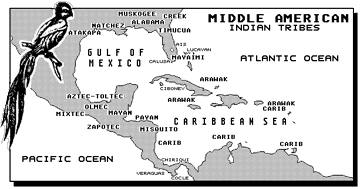
Our early ancestrial tribes in Middle America.
The word CARIBBEAN is based on the perspective that when European explorers first visited the western tropical Atlantic realm they met native seafarers which carried with them edible beans for trade. Thought to be a version of the European legume called
CAROB, the explorers named these native seafarers CARIBS that
traded BEANS - and thus the name of the realm became known as the
CARIBBEAN. However, the bean in question was not CAROB, but was
rather COCOA - as in COCOA BEANS and is used to make THEOBROMINE
CHOCOLATE - or "God's food" (Theo-broth). Both CAROB
and COCOA are rich in natural nutrients, but COCOA contains the
accelerate alkaloid CAFFEINE - which may have been the special
"spice" that Columbus heard about because it came from
places like JAVA and CATHAY (Coffee and Cafe). CAROB beans are
smaller than COCOA beans and was the assumed food that St. John
used to survive in the "wilderness" during his
"western wanderings".
Because nature's elements can be "repackaged" by plants
and animals, and because some elements need to be
"chelated" - or combined in a metallic cell-like cyclic
structure before they can be used by the body, some plants may be
better as a nutritional food source than others. The COCOA plant,
which produces COCOA BEANS, was once the monetary unit of trade
of the Carib natives in the Caribbean Basin. This plant may be
one of the best types of plants that could "package"
the long-lasting and durable nobel elements from the soil for
human consumption.
V4
Chapter 2: The Quest for Memory
1/ If it were not for the contentious aggressiveness of the
Spanish Conquest from the east, which devastated native american
cultures and ignorantly melted down their gold and silver
sculpture into metal ingots - and if it were not for the
religious persecution of previous artistry by the Toltec invasion
from the west, which introduced sacrificial heart-removing
rituals and distorted the time-keeping habits of the original
inhabitants, certain remarkable artifacts could have survived the
antediluvian age in the New World and revealed priceless
knowledge concerning the origins of humanity.
2/ The plundering of native american artifacts and the
confusion of their historical value can also be traced to the
anarchist era of the Caribbean pirates - in that certain
priceless treasures were lost because of ignorance and greed.
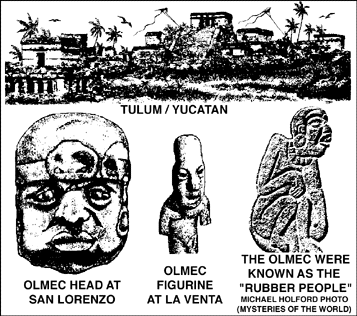
The Olmec civilization in Middle America.
The Olmec - or Mayan ancestors, may have built many seaside cities. The original foundation of the Yucatan seaside city of
Zama could have been one long before the Toltecs renamed it Tulum.
The Olmec civilization of Middle America has been called the
"Mother culture of the Caribbean Basin" by many historians. As ancestors to the Maya, the Olmec invented a remarkable mathematical language and an extraodinary calendar system based on the True Tropical Solar Year count. The reason of their disappearance from history can now be traced to the cometary conflagaration of the Phaethon incident.
3/ By searching through Middle American historical records, we
discover that the ancestors of the Mayan culture were the oldest known civilization of the Caribbean
Basin known as the Olmec - whose name translates into the the
term "rubber people".
(Although the term "rubber people" is believed by many
historians to have the meaning: "people of the rubber
growing regions", perhaps the term may also mean:
"flexible people" - because the Olmec natives could
have lived with a diet high in fluorine and calcium which
promotes rubber-like bones and flexible bodies)
4/ It is known the Olmec were of a highly resourceful culture
that employed a mysterious science during the construction and
deployment of huge "baby-faced" statues - some of which
weighed approximately twenty tons and over eight feet high.
5/ Conventional textbooks date the Olmec culture of Middle
America to older than the Greco-Roman Era - whereby they managed
to consolidate communication between regional family tribes by
using the dot/dash style of phonetic numbers.
6/ The appearance of the Olmec looked somewhat Mongoliod and
Negroid - with some Caucasian features, such as the bearded
"uncle-sam" rendition found on several Olmec
stone-works.
7/ What the Olmec peoples called themselves is not known,
however, substantial evidence exist that gives them a cultural
identity unique to Middle America.
8/ This cultural identity is founded on the idea that the
Olmec were the first true natives of the Neolithic Age in Middle
America.
9/ What made them unique was their ability to create
remarkable and enduring artifacts that reflect great detail and
craftsmanship.
10/ Perhaps the elemental makeup of their environment
contributed to their uniqueness as a culture.
11/ Perhaps certain precious and lasting materials may have
contributed to their place in history.
12/ Perhaps the Olmec culture was born from a unique region
where the auric soil and perennial fruit contributed to their
creative abilities.
13/ Perhaps the Olmec were exposed to the same valuable
elements that inspired Spain to send hundreds of galleons across
the Atlantic.
14/ Is gold and silver, when properly assimilated within the
body, responsible for the extreme durability of human memory?
15/ Is the human ability to remember and retain infinite
knowledge the major factor that separates man from animal?
16/ Did the fruit from the "Tree of Knowledge", in
the Garden of Eden, give man the immortal power of knowing or
"remembering" good from evil?
17/ If humans are a product of their environment, then the
Olmec may have been a product of a auriferous region, in which
micro-nutritional gold or silver - and even platinum base salts,
may have created the first true human beings.
18/ In other words, the Olmec - because of their "Golden
Apatite" may have been the first real tribe of humanity!
(The elements of gold, silver and platinum can be found in other
regions of the world, but possibly not in conjunction with
certain manganic, selenic and oxalic acids, which are capable of
dissolving the elements into small enough particles for organic
plant/animal consumption)
19/ And so it is possible that a tropical american culture
nautically evolved into a fleet of wandering legions which sailed
the summer regions and became the Euro-Afro-Austro-Asians!
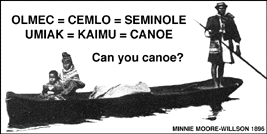
The Mayaimi / Mayan / Miamian natives.
Because early writing was spelled and pronounced backwards,
perhaps the origins of humanity can also be understood as
interpreted backwards - as in the evolution of modern man may
have originated in the New World continent of Atlantis and not
the conventional recorded view of the Afro-Eurasian continent.
However, it should be understood that as modern Neolithic Man was
nautically colonizing the shores of the Old World from the New
World, our historical records and technological tools were
improved during this migration - therefore, much of the
historical energy behind our modern civilization was a global
undertaking and no one region should claim sole credit for our
origins.
20/ Therefore, in conclusion, perhaps the tropical american
samaritans of summer - the Olmec or "OLD AMERICANS",
will someday soon be traced to an antediluvian seaport garden city,
now sunken in a freshwater lake that leads into the western Caribbean Sea, just as Plato describes in his legacy of ATLANTIS.
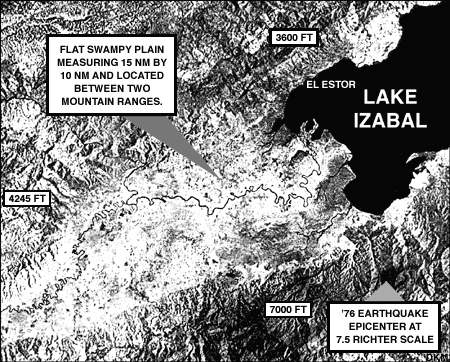
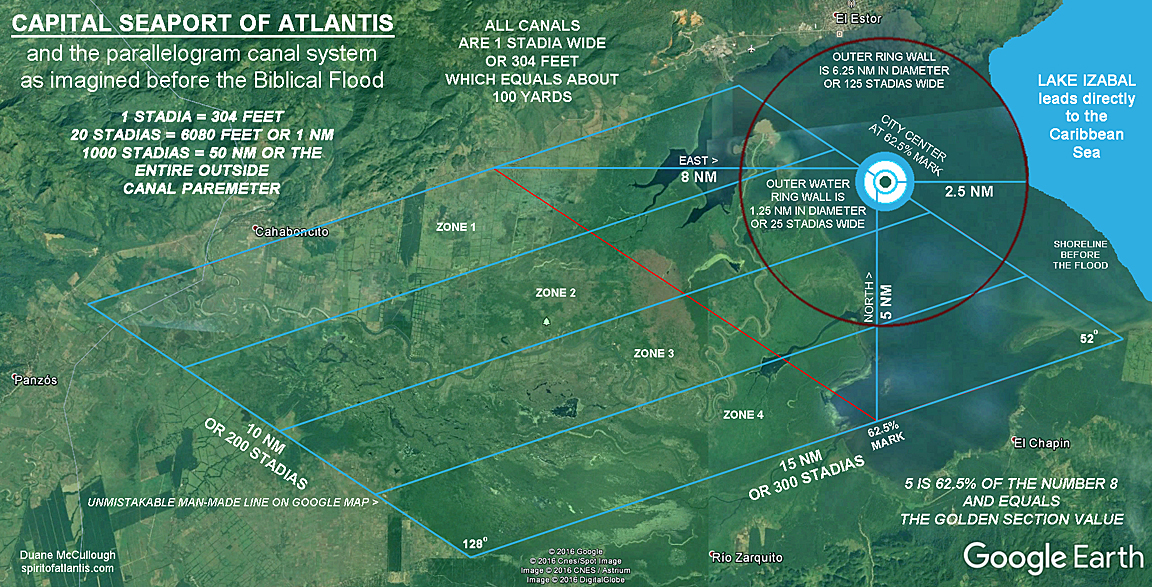
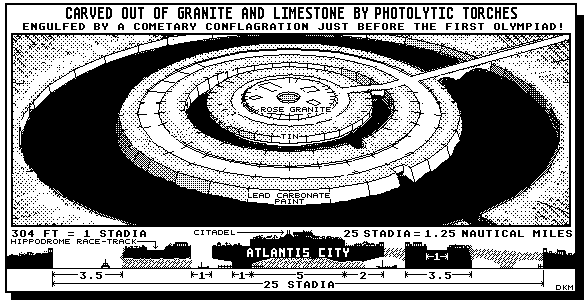
Plato's elusive seaport of Atlantis.
Plato is quoted as describing a flat plain which was adjacent to the seaport city of Atlantis that measured the translated
dimensions of 15 nm by 10 nm. The plain also was "shaped" by
"cutting canals into and along the edge of the plain".
The nearby city of El Estor may be a remnant of the once glorious
"store" in the jungle that coastal visitors could shop for supplies.
Return to the Volume 4





